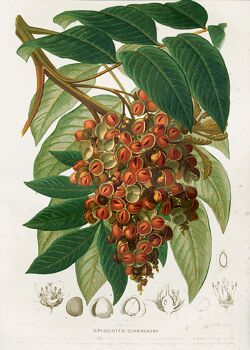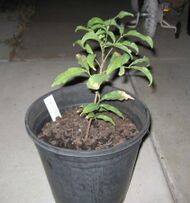Biology:Diploglottis
| Diploglottis | |
|---|---|

| |
| Diploglottis australis | |
| Scientific classification | |
| Kingdom: | Plantae |
| Clade: | Tracheophytes |
| Clade: | Angiosperms |
| Clade: | Eudicots |
| Clade: | Rosids |
| Order: | Sapindales |
| Family: | Sapindaceae |
| Tribe: | Cupanieae |
| Genus: | Diploglottis Hook.f.[1] |
| Species | |
|
See text | |
Diploglottis is a genus of 10 species of trees known to science, constituting part of the plant family Sapindaceae. They grow naturally in rainforests and margins of adjoining humid forests in eastern Australia and New Guinea.[2] Some species are known as native tamarind or small-leaved tamarind; they have no direct relationship with the true tamarind.
One Australian species, D. australis is grown as a street tree in the Northern Rivers area of New South Wales, principally Lismore and is known locally as the native tamarind.
Another endemic Australian species is D. campbellii, also known as the small-leaved tamarind, is rare and threatened and is restricted to a small number of sites each with a maximum of three trees per site. There are a total of 42 known mature wild trees in south-east Queensland and north-eastern New South Wales. However, the tree, as a seedling, is readily available from nurseries in the Northern Rivers area of New South Wales, and in south-eastern Queensland. The small-leaved tamarind grows to 30 metres and has a compact canopy, making it good to use as a screening tree. It has small three-lobed fruit capsules. The fruit is edible and is commercially produced as bushfood. It is red when ripe and can be made into jam.

Naming and classification
The species currently known as D. australis was the first that European scientists collected specimens of, for instance botanist Robert Brown in 1804.[1][3] Before formal naming, this species was grown up to a flowering tree in a glasshouse in Kew gardens, UK.[3] In 1862 Joseph Dalton Hooker first established this genus name Diploglottis in Genera Plantarum and the following year George Bentham formally published the D. cunninghamii name combination.[3] Earlier in 1831 however, George Don had published a formal description of this taxon named with the epithet australis, with a different name genus.[3] In 1878–9 Ludwig A. T. Radlkofer published his referral of this taxon to the name combination Diploglottis australis.[3] In 1986 Gwen Harden and Lawrie Johnson published the clarification of the further involved history of these names.[3] Sally T. Reynolds had proposed D. cunninghamii as the correct name in 1981.[4] Harden and Johnson clarified that D. australis legitimately has support as the correct name, for this type species.[3]
In 1978 P. W. Leenhouts described the new species D. bracteata.[5] In 1981 and 1987 Reynolds described several different new species.[4][6] In 1985 Reynolds’ account of the genus in Australia was published in the Flora of Australia volume 25.[7] In 1994 in Flora Malesiana P. W. Leenhouts included D. australis occurring in New Guinea, however the record has been corrected to the superficially similar D. diphyllostegia which in Australia also grows in areas adjacent to New Guinea and further north than the northernmost D. australis records.[8][9][10]
Species
- D. australis (G.Don) Radlk.; syn: D. cunninghamii (Hook.) Hook.f. ex Benth.; Native tamarind – E. NSW, Qld, Australia[4][7][11]
- D. bernieana S.T.Reynolds – NE. Qld, Australia[6][7][12]
- D. bracteata Leenh.[5] – NE. Qld, Australia[4][7][13]
- D. campbellii Cheel; Small-leaved tamarind – SE. Qld, NE. NSW, Australia[4][7][11]
- D. diphyllostegia (F.Muell.) F.M.Bailey; syn: D. cunninghamii var. diphyllostegia – C. to NE. Qld, Australia, New Guinea (–as D. australis[9])[4][6][7][14]
- D. harpullioides S.T.Reynolds – NE. Qld, Australia[4][7][15]
- D. macrantha S.T.Reynolds – NE. Qld, Australia[4][7][16]
- D. obovata S.T.Reynolds – C. Qld, Australia[6][7][17]
- D. pedleyi S.T.Reynolds – NE. Qld, Australia[4][7][18]
- D. smithii S.T.Reynolds – NE. Qld, Australia[4][7][19]
Ecological connections
Diploglottis species are used as food plants by the hepialid moths Aenetus ramsayi and Aenetus scotti.
References
- ↑ 1.0 1.1 "Diploglottis%". Australian Plant Name Index (APNI), Integrated Botanical Information System (IBIS) database. Centre for Plant Biodiversity Research, Australian Government. http://www.anbg.gov.au/cgi-bin/apni?00TAXON_NAME=Diploglottis%25.
- ↑ Cooper, Wendy; Cooper, William T. (June 2004). Fruits of the Australian Tropical Rainforest. Clifton Hill, Victoria, Australia: Nokomis Editions. pp. 485–488. ISBN 9780958174213. https://www.nokomis.com.au/product/nokomis-published-books/fruits-australian-tropical-rainforest/. Retrieved 21 June 2021.
- ↑ 3.0 3.1 3.2 3.3 3.4 3.5 3.6 Harden, Gwen J.; Johnson, Lawrence A. S. (1986). "A Note on Diploglottis australis (G.Don) Radlk..". Telopea 2 (6): 745–8. doi:10.7751/telopea19864613.
- ↑ 4.00 4.01 4.02 4.03 4.04 4.05 4.06 4.07 4.08 4.09 Reynolds, S. T. (1981). "Notes on Sapindaceae in Australia, I.". Austrobaileya 1 (4): 390–8.
- ↑ 5.0 5.1 Leenhouts, P. W. (1978). "A new species of Diploglottis (Sapindaceae) and its systematic position". Blumea 24 (1): 173–9. http://www.repository.naturalis.nl/record/525442. Retrieved 21 May 2015.
- ↑ 6.0 6.1 6.2 6.3 Reynolds, S. T. (1987). "Notes on Sapindaceae in Australia, V". Austrobaileya 2 (4): 328–338.
- ↑ 7.00 7.01 7.02 7.03 7.04 7.05 7.06 7.07 7.08 7.09 7.10 Reynolds, Sally T. (2014). "Diploglottis". Flora of Australia (online version, incl. species updates). 25—Melianthaceae to Simaroubaceae. CSIRO Publishing / Australian Biological Resources Study. pp. 33–38. ISBN 978-0-644-03724-2. http://www.anbg.gov.au/abrs/online-resources/flora/stddisplay.xsql?pnid=48625. Retrieved 24 Aug 2014.
- ↑ Leenhouts|1994}}|Leenhouts (1994) Flora Malesiana. Digitised, online "Diploglottis". http://bhl.ala.org.au/page/28496639.
- ↑ 9.0 9.1 Leenhouts|1994}}|Leenhouts (1994) Flora Malesiana. Digitised, online "Diploglottis australis". http://bhl.ala.org.au/page/28496639.
- ↑ Conn, Barry J. (2008). "Diploglottis" (Online, from pngplants.org/PNGCensus). Census of Vascular Plants of Papua New Guinea. http://pngplants.org/cgi-bin/PNGcensus.pl?fam=&gen=Diploglottis&sp=&infr=&group=.
- ↑ 11.0 11.1 Harden, Gwen J. (Dec 2003). "Diploglottis – New South Wales Flora Online". PlantNET – The Plant Information Network System. Sydney, Australia: The Royal Botanic Gardens and Domain Trust. http://plantnet.rbgsyd.nsw.gov.au/cgi-bin/NSWfl.pl?page=nswfl&lvl=gn&name=Diploglottis.
- ↑ "Diploglottis bernieana". Centre for Australian National Biodiversity Research (CANBR), Australian Government. 2020. https://apps.lucidcentral.org/rainforest/text/entities/Diploglottis_bernieana.htm.
- ↑ "Diploglottis bracteata". Centre for Australian National Biodiversity Research (CANBR), Australian Government. 2020. https://apps.lucidcentral.org/rainforest/text/entities/Diploglottis_bracteata.htm.
- ↑ "Diploglottis diphyllostegia". Centre for Australian National Biodiversity Research (CANBR), Australian Government. 2020. https://apps.lucidcentral.org/rainforest/text/entities/Diploglottis_diphyllostegia.htm.
- ↑ "Diploglottis harpullioides". Centre for Australian National Biodiversity Research (CANBR), Australian Government. 2020. https://apps.lucidcentral.org/rainforest/text/entities/Diploglottis_harpullioides.htm.
- ↑ "Diploglottis macrantha". Centre for Australian National Biodiversity Research (CANBR), Australian Government. 2020. https://apps.lucidcentral.org/rainforest/text/entities/Diploglottis_macrantha.htm.
- ↑ "Diploglottis obovata". Centre for Australian National Biodiversity Research (CANBR), Australian Government. 2020. https://apps.lucidcentral.org/rainforest/text/entities/Diploglottis_obovata.htm.
- ↑ "Diploglottis pedleyi". Centre for Australian National Biodiversity Research (CANBR), Australian Government. 2020. https://apps.lucidcentral.org/rainforest/text/entities/Diploglottis_pedleyi.htm.
- ↑ "Diploglottis smithii". Centre for Australian National Biodiversity Research (CANBR), Australian Government. 2020. https://apps.lucidcentral.org/rainforest/text/entities/Diploglottis_smithii.htm.
Cited works
- "Australian Tropical Rainforest Plants Home". Centre for Australian National Biodiversity Research (CANBR), Australian Government. 2020. https://apps.lucidcentral.org/rainforest/text/intro/index.html.
- Adema, F.; Leenhouts, P. W.; van Welzen, P. C., eds (1994). "Diploglottis". Flora Malesiana. Series I, Spermatophyta : Flowering Plants. 11 pt. 3: Sapindaceae. Leiden, The Netherlands: Rijksherbarium / Hortus Botanicus, Leiden University. pp. 520–2. ISBN 90-71236-21-8. https://www.biodiversitylibrary.org/page/28496639.
External links
- "Diploglottis Hook.f.". Atlas of Living Australia. https://bie.ala.org.au/species/http://id.biodiversity.org.au/node/apni/9437499.
Wikidata ☰ Q3368064 entry
 |

